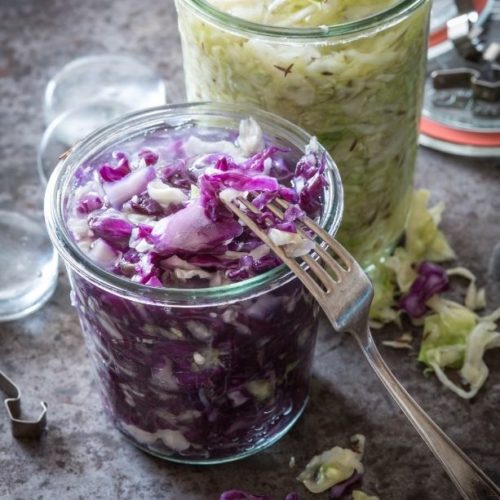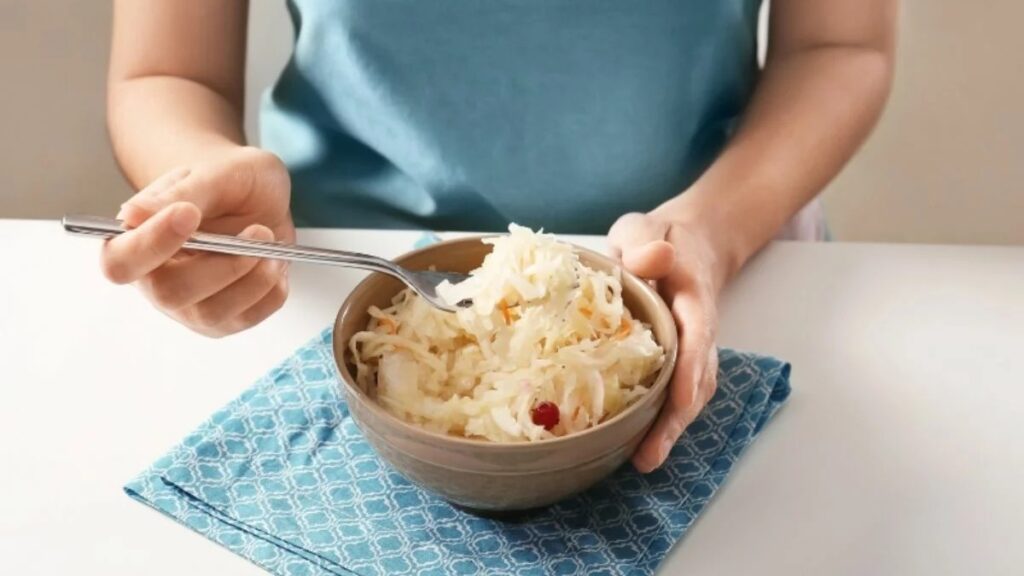Here is a simple recipe for lacto-fermented cabbage that will make you love sauerkraut and lacto-fermentation!
Homemade sauerkraut is a fermentation classic! It is also often the baptism of the apprentice “fermenter”.
Cabbage, salt, and a few weeks of patience are all you need to get started!
Lacto-fermented cabbage, also known as “salt sauerkraut”, is a delicious, easy-to-digest condiment that is simple to make at home. It is less acidic than pickled sauerkraut and is loaded with probiotics and goodness!
This article will guide you step-by-step through your first experiments with lacto-fermentation. As this recipe is a classic, we are sure you will come back to it many times!
Go straight to the section that interests you:
- What Equipment Do You Need to Make Sauerkraut?
- Ingredients for Making Fermented Cabbage
- Lacto-Fermented Sauerkraut Recipe
- Other Sauerkraut Recipes
- Frequently Asked Questions
What Is Sauerkraut Fermentation?
Sauerkraut contains only two basic ingredients: cabbage and salt!
But sauerkraut is much more than just salted cabbage. Under the right conditions, cabbage is transformed by lactic acid bacteria into fermented cabbage.
These good bacteria eat the sugar in the cabbage and create lactic acid. This is where the good, tangy taste of sauerkraut comes from! Over time, cabbage becomes more and more acidic and softer: it turns into sauerkraut.
Making homemade sauerkraut from a plain cabbage is very easy:
- Cut and salt the cabbage
- Put the cabbage in a jar, in an oxygen-free environment
- Let it ferment at room temperature
- Devour!
Sauerkraut is easier to digest than raw cabbage and is full of good probiotic bacteria. It’s delicious living food! For more information, check out the science behind fermented vegetables.
What Equipment Is Required to Ferment Cabbage?
To make sauerkraut, you need to be well equipped! There are several options for creating the perfect environment for fermentation.
Jar
The jar is used to keep the sauerkraut in an oxygen-free environment. We like to use glass jars like Mason jars or Le Parfait jars.
Weight
The cabbage should never be exposed to oxygen! You need to add a weight to keep the sauerkraut submerged.
Types of weights:
- Glass weight
- ViscoDisc insert
- Plastic bag filled with water
- Small glass jar that fits into the opening
Other useful material
- Chef’s knife or mandoline
- Cutting board
- Kitchen scale
- Large mixing bowl
- Fermentation packer (optional, but useful!)
For more information, check out our Sauerkraut Making Kit or our Guide to Choose Your Fermentation Equipment.
Lacto-Fermented Sauerkraut Ingredients
Salt-based fermented sauerkraut contains few ingredients, but lots of flavour!
Cabbage
Any cabbage can be fermented! Start with green or red cabbage, which gives delicious results.
Choose a fresh, firm cabbage. Although recommended, cabbage does not have to be organic to ferment well.
For more information, see: Best Cabbage for Sauerkraut?
Salt
Salt keeps bad microorganisms at bay! It is essential for lacto-fermentation.
You need about 20 g of salt per kg of cabbage, or about 4 teaspoons of salt.
Choose salt without additives, where the only ingredient is “salt”. Sea salt and pickling salt are two good choices.
For more information, see: Which Salt for Lacto-Fermentations
Spices
Plain sauerkraut is good. Spicy sauerkraut is even better!
You can add your favourite spices to season your sauerkraut. The most popular spices are juniper berries, bay leaves, and caraway seeds.
Lactic Acid Bacteria
Without lactic acid bacteria, there is no fermentation! The good news is that you don’t have to get them, they are already present on and in the cabbage.
When you place the cabbage in a jar with salt, it will create the perfect environment for these bacteria, which will quickly multiply and produce what is called lactic acid fermentation.

Sauerkraut (Fermented Cabbage) Recipe
Equipment
- 1 Le Parfait jar 1L
- 1 ViscoDisc insert Large
- 1 Cutting board
- 1 Chef's knife
- 1 Kitchen scale
- 1 Large mixing bowl
- 1 Pickle packer tamper optional
- 1 Fine blade mandoline optional
Ingredients
- 2.2 lb green or red cabbage
- 4 tsp sea salt
- 1 tsp caraway optional
- 1 tsp black pepper optional
Steps
Cabbage Preparation
- Gather ingredients and equipment.
- Lightly rinse the cabbage and remove any dirty or damaged parts.
- Tear off a large cabbage leaf and set it aside for later.
- Using a chef's knife or mandoline, finely slice the cabbage. Place in a large bowl. Discard the cabbage core.
- Sprinkle the salt and spices over the cabbage.
- Mix thoroughly with your hands (about 1 minute).
- Allow soaking for at least 15 minutes.
- Mix again for 1 minute with your hands. The cabbage will release some of its water.
Putting in Jar
- Fill the jar with vegetables. Pour in the vegetable juice. Squeeze well as you go along.
- Fill the jar up to 1 inch (3 cm) from the rim.
- Place the reserved cabbage leaf on top and press down well. It helps to keep the vegetable chunks oxygen-free. This leaf will not be eaten.
- Place the insert on top of the cabbage leaf, folding the sides up.
- Add water if the vegetable juice does not cover the cabbage leaf.
- Close the lid of the jar.
Fermentation
- Place the jar on a large plate in case it overflows during fermentation.
- Store the jar for 3 weeks at room temperature without opening it.
Notes
Frequently Asked Questions About Sauerkraut
How to eat fermented sauerkraut?
Fermented sauerkraut is eaten either raw or cooked, as a condiment.
- In a sandwich
- In a burger
- In a hot dog
- In a Buddhan abundance bowl
- In a wrap
- Mixed with mashed potatoes
What Is the Difference Between Pickled and Fermented Sauerkraut?
Sauerkraut can be prepared in two different ways: by fermentation or by adding vinegar.
Pickled sauerkraut is a cabbage preparation cooked and mixed with vinegar and spices. It is often available in shops in pasteurized form.
Fermented sauerkraut has a milder and richer flavour. It is also tangy but contains probiotic bacteria.
For more information, see What is the Difference between Pickling and Fermentation?
How Do I Know if My Cabbage Has the Right Bacteria?
Are you afraid to start because you don’t know if your cabbage contains the right bacteria?
Lacto-fermentations are very, very difficult to fail. Unless your cabbage has been frozen or cooked, chances are it has lactic acid bacteria!
Trust the process, it will work! To find out more, read our guide on How to Ferment Vegetables.
Do I Need to Wash the Cabbage Before Using It?
We recommend removing the outer leaves and giving the cabbage a quick rinse. Lactic acid bacteria live on the surface of the leaves, but also in the cabbage.
Are There Any Dangers in Making Fermented Sauerkraut? Could I Be Poisoned?
Lacto-fermentation is a very safe process! It is a safe way to preserve and process food at home.
The salt and acidity of the fermentation process protect the vegetables from harmful microbes and bacteria. Vegetables can be preserved for months without risk of contamination.
For more information, read Is Lacto-Fermentation Safe?
How Do I Know if My Sauerkraut Is Successful?
It is very, very easy to identify a faulty lacto-fermentation:
- Presence of white, green, blue, or black mould on the surface
- Foul smell of forgotten garbage under the sun in the middle of a heat wave
- No one would eat this voluntarily!
On the contrary, successful sauerkraut will have these characteristics:
- Acidic smell and taste
- Softer texture
- Presence of bubbles (sometimes)
For more information, see Frequently Asked Questions: Is My Lacto-Fermentation Normal?
Can I Add Other Ingredients and Vegetables to the Sauerkraut?
Yes, it’s your sauerkraut, you choose what to add!
You can add vegetables, spices, and even mushrooms or seaweed! As a general rule, anything that is eaten raw can be eaten fermented.
Let our sauerkraut recipes inspire you!
- Sauerkraut with cumin
- Apple and onion sauerkraut
- Curtido (Salvadoran sauerkraut)
- Eastern European sauerkraut

